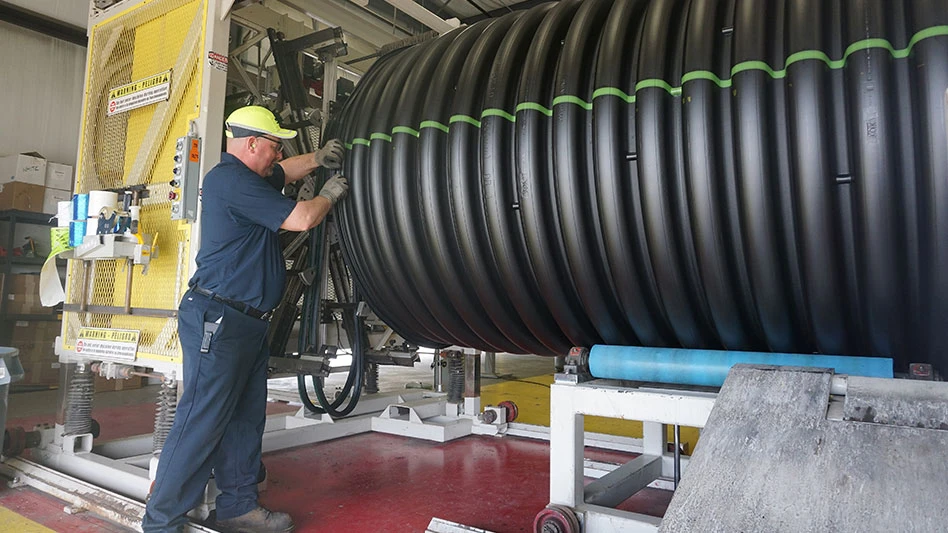
Photo courtesy of ADS
A new report from the National Academies of Sciences, Engineering and Medicine makes specific recommendations for how the Environmental Protection Agency (EPA) and the Department of Transportation (DOT) can work together to promote and sustain a coordinated government response to end-of-life plastics in the U.S. that includes assessments of using recycled plastics in infrastructure.
The study, undertaken by the National Academies of Sciences, Engineering and Medicine’s Committee on Repurposing Plastics Waste in Infrastructure, was sponsored by the U.S. DOT and the U.S. EPA.
According to the report, it is in society’s economic and environmental interests to expand and standardize collecting plastics at the end of their lives, increase recycling and explore new applications for recycled in infrastructure. Recycled plastics are an underused resource, with action from the public sector at the federal, state and local levels needed to improve the U.S. plastics waste management system, NASEM says.
According to the report, plastic waste management activities are not well-coordinated between the public and private sectors, and research and development for capturing, processing and reusing plastics in consumer products and infrastructure are not far advanced.
The large number of plastic types and formulations; the high cost and complexity of collecting, sorting and cleaning end-of-life plastics; and other cost and technical challenges associated with processing plastics hinder collection, recycling and reuse of plastics, the report says. Because of these complexities, demand for recycled plastics exceeds the supply of suitable material, the report states.
“There are isolated examples of successful plastics recycling in the U.S., but, overall, there is ample opportunity for higher levels of collection, reprocessing and reuse of plastics,” says David Dzombak, a Hamerschlag University Professor Emeritus at Pittsburgh’s Carnegie Mellon University and the chair of the committee that wrote the report. “Determining exactly which pathways to pursue, however, depends on goals, policy and economics. A coordinated direction for policy and research is key for advancement of plastics recycling in the U.S.”
Using recycled plastics in infrastructure applications could divert more of this material from landfills and litter. Four types of plastics—polyethylene terephthalate (PET), high-density polyethylene (HDPE), low-density polyethylene (LDPE) and polypropylene (PP)—have properties that make them conducive to use in infrastructure, such as their suitable melting points and service temperature ranges, chemical resistance and strength, according to the report. These plastics also represent those most collected and recycled from waste streams, and they are in demand for use in products such as in bottles and other forms of packaging, carpet and clothing.
While infrastructure products including asphalt pavement mixes, drainage pipes and railroad ties have attracted varying levels of commercial interest to incorporate recycled plastics, only drainage pipes are a source of significant demand presently, the report notes. Advanced Drainage Systems, or ADS, is a pipe manufacturer and also among the largest recyclers of HDPE and PP in North America, for instance.
Also, one of the greatest infrastructure opportunities to use recycled plastics could be pavements, while bike paths, composite utility poles and highway sound barriers offer other opportunities. However, according to the report, a range of factors inhibit adoption, such as a lack of familiarity, uncertainties over formulation and methods of use, unknowns regarding environmental impacts, including the potential release of microplastics, and effects on long-term performance.
The report suggests the DOT build on existing efforts to support a multiyear field-testing program to assess the environmental and health impacts, overall service life and effects of plastics additives on the use and recyclability of asphalt pavements. It further recommends the EPA support the research and data collection required to understand and evaluate the potential environmental, human health, economic and performance implications of each new use of recycled plastics.
The EPA should expand the means for tracking and modeling the supply of recycled plastics and the demand generated by different applications, with distinctions by quality and polymer type, and accounting for geographic imbalances, according to the report.
Increasing the overall supply of high-quality recycled plastics that can be used in infrastructure and other applications is important and will require supportive policies and practices in all parts of the process, from collection and processing to incentives for reuse, the report states. Examples include state laws and regulations requiring recycling programs, increasing extended producer responsibility and federally funded research into new product and materials design.
Additionally, the report notes that market-driven processes that encourage improvements in the collection and processing of postuse plastics in the U.S. could increase suitable supplies. Therefore, it recommends the EPA work to identify specific policies and regulations to support and incentivize plastics recycling and take steps to encourage and facilitate more collaboration among plastics manufacturers, suppliers, recyclers, industrial and infrastructure users.
The report makes other recommendations:
- EPA should lead in strengthening interagency coordination, and work with others, including DOT, the U.S. Department of Energy, the National Science Foundation, the National Institute of Standards and Technology and the Army Corps of Engineers, to consider and advise on how each can apply its research and expertise more effectively to plastics waste, recycling and reuse.
- DOT should inventory current and prospective transportation applications for recycled plastics; work to understand impediments to their development and use; assess waste reduction impacts; and determine how to increase marketplace demand in appropriate infrastructure industries.
The National Academies of Sciences, Engineering and Medicine are private, nonprofit institutions that provide independent, objective analysis and advice to the nation to solve complex problems and inform public policy decisions related to science, engineering and medicine.
Get curated news on YOUR industry.
Enter your email to receive our newsletters.
Latest from Recycling Today
- EU enhances CBAM through new legislative measures
- Plastics treaty talks end with no agreement
- Comstock Metals shares solar recycling plans
- Longtime Tennessee metals recycling site poised for redevelopment
- ASTM proposes standard for recycled-content carbon black
- Advocacy group offers unflattering chemical recycling portrayal
- DOE grants emphasize battery materials recycling
- ConExpo registration process underway






